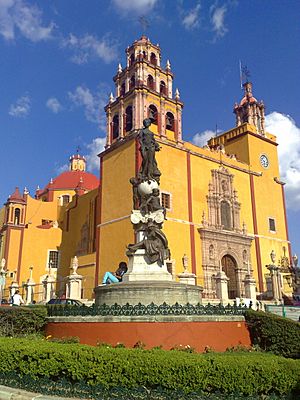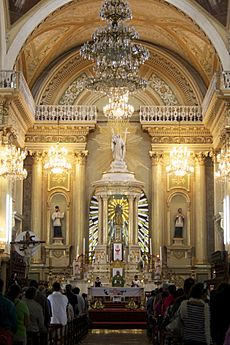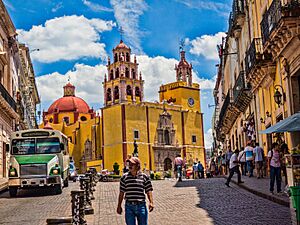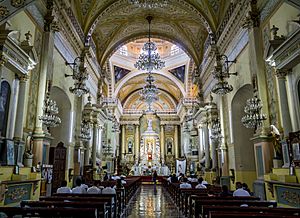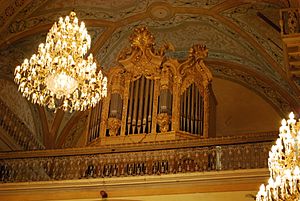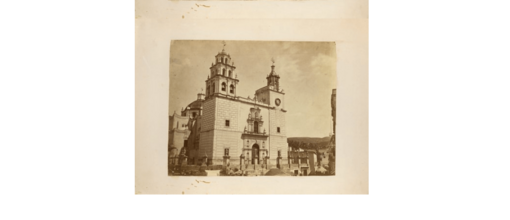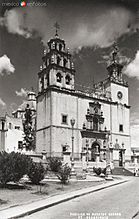Basílica colegiata de Nuestra Señora de Guanajuato facts for kids
The Basílica colegiata de Nuestra Señora de Guanajuato is a very important and beautiful building in the City of Guanajuato, Mexico. You can find it in the Plaza de la Paz, right in front of the sign that says Guanajuato is a UNESCO World Heritage Site. This church became a special "basilica" in 1957. It was built a long time ago, between the years 1671 and 1696.
Our Lady of Guanajuato Statue
Inside this amazing Baroque-style building, the main altar is covered in gold. It protects a special statue called Our Lady of Guanajuato. This statue is the patron saint and queen of the city. It's an old wooden sculpture of the Virgin Mary holding Baby Jesus.
King Charles V, Holy Roman Emperor and his son Philip II gave this statue to the people of Guanajuato. They gave it on August 8, 1557. This was a thank you for all the gold and silver mined in the city. The statue is 1.15 meters tall. It is made of cedar wood and has a silver base.
Originally, the statue held a rose in its right hand. When it came to Mexico, the rose was changed to a scepter. A crown and a solid silver stand were also added. Every year on August 8, people celebrate the statue's arrival. This gift showed how important Guanajuato was as a mining city in New Spain.
Many important events happened in this basilica. For example, Albino García, a fighter during the Mexican War of Independence, was baptized here.
Building's Design
The Basílica colegiata de Nuestra Señora de Guanajuato was built from 1671 to 1696. Its outside looks like a mix of Baroque and Neoclassical styles. The main entrance has three parts. Inside, the church is shaped like a Latin cross. It has a long main hall, a dome, and two bell towers. The main altar is golden and holds the statue of Our Lady of Guanajuato.
Rich miners from Guanajuato paid for the church's building and decorations. Besides the city's patron saint, the church also has statues of the Sacred Heart of Jesus and Saint Ignatius of Loyola. High up on the central altar, there is a statue of Santa Fe de Guanajuato. This name refers to Santa Fe de Granada, where the original image came from. It also refers to the city's old name, "Royal of Mines of Santa Fe de Guanajuato."
Inside, there is a huge pipe organ with 1098 pipes. The church also has beautiful tapestries and grand Neoclassical towers on the outside.
Who Paid for It?
During the time this church was built, wealthy people in New Spain, called Criollos, wanted to show off their importance. They often paid for big religious projects like churches. This was a way for them to show their faith and also their pride. They believed it would help them get into heaven. It also helped them become more famous and respected in society.
The Basílica was built thanks to this idea of "patronage." Rich mine owners, like Antonio de Obregón y Alcocer from the Valenciana Mine, helped pay for it. They wanted to make sure their names were remembered.
Gallery
See also
- List of buildings in Guanajuato City
 In Spanish: Basílica colegiata de Nuestra Señora de Guanajuato para niños
In Spanish: Basílica colegiata de Nuestra Señora de Guanajuato para niños


